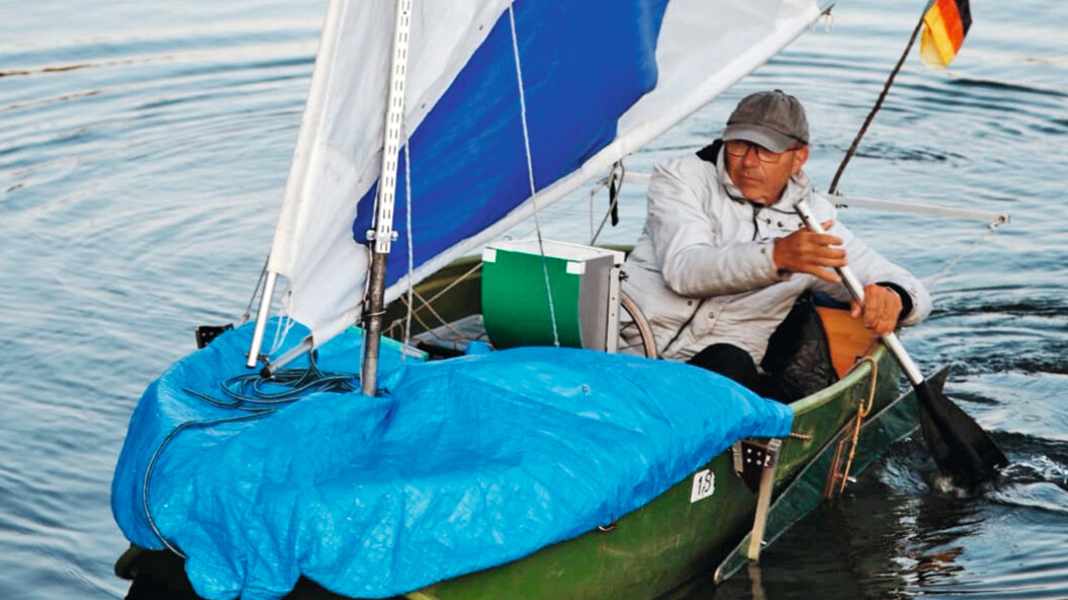
Suddenly I found myself in a minefield of breaking waves. A lot of shallows became visible around me. It was too late to turn round, so I said to myself: 'Eyes closed and through! But the very next moment I found myself in the gurgling water, the boat floating keel-up above me. Fortunately, I was able to free myself underwater from a line that had become wrapped around my neck when I capsized. I then surfaced and pulled myself onto the flat hull.
The seconds Paul Lenz recounts are dramatic. What he had not thought possible had materialised: his Banana boat could not withstand the force of the water.
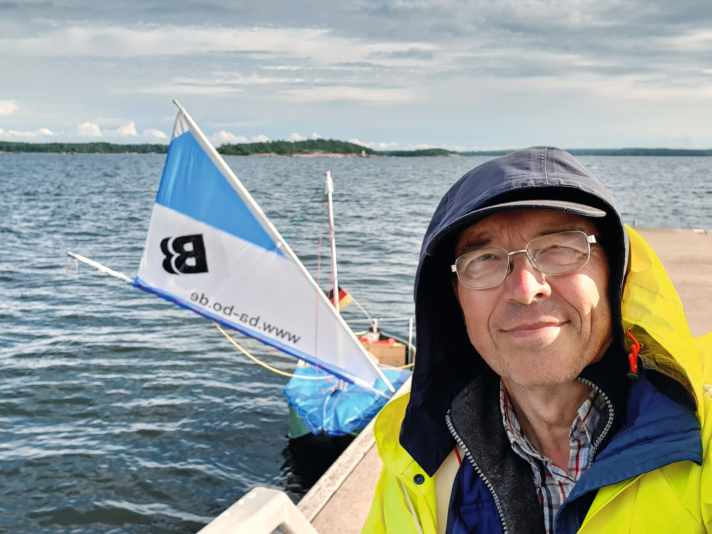
The boat then drifted with me towards the open sea. And dusk began to fall. I had no choice. I let myself slide into the water and swam towards land in full gear. After what felt like an eternity, I pulled myself onto the shore of an island with the last of my strength. My boat was gone, everything was lost. I felt like a beaten dog.
The accident that Paul Lenz is reporting on happened in the summer of 2019, when he was on a highly unusual journey along the Finnish coast. To understand what drove him to undertake this endeavour, you have to look back a long way.
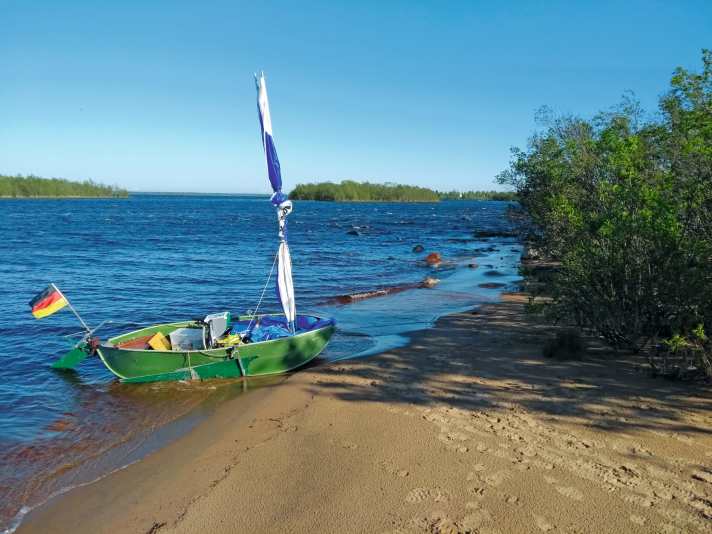
This story begins in 1969, the year of the first moon charge. Lenz has just turned 16 and receives a sailing course on the Steinhuder Meer as a gift from his father. In the years that followed, he gained experience in small boats such as the Pirat, VB dinghy and Neptun 17. His desire to have his own boat grew, but there was hardly any parking space in Hanover. He also finds trailering "kind of daft", and storing a boat at Steinhuder Meer is "far too inflexible", as he says. Time went by and Lenz was now working as a civil engineer for a bridge construction company in Hanover when he came across a photo of a Banana boat in 1990.
I knew immediately that this was it! Foldable to the size of a surfboard, it needed neither a trailer nor a summer or winter berth. And I also saved myself annoying and costly maintenance work - the boat simply went into the cellar. The best thing, however, was that it fitted in the car and I could drive it anywhere.
While Germany is in the throes of the World Cup and the impending reunification, Lenz completes his first test runs with his new small boat on Hanover's Maschsee lake and various gravel pits. Over the next few years, he set himself ever greater challenges. He sails the Limfjord with the Banana boat, crosses the Øresund and conquers the large lakes in Sweden and Finland. He even tackles the Croatian coast, where he sometimes chases across the Adriatic at almost seven knots. Remarkable for a boat that, due to its design, bends so much even in moderate gusts that it can hardly convert the wind pressure into speed.
Typical of Paul Lenz is also his certain ignorance of all things traditional.
To this day, nautical vocabulary only affects me peripherally. I think and calculate in kilometres and km/h and prefer left and right to port and starboard," he admits frankly. "In this respect, I will always be a landlubber.
To make his boat more suitable for the big voyages, he refits it. His great passion for inventing technology and machines of all kinds comes in handy here. He has already developed a wide variety of mostly curious gadgets, such as the Synthomelodicon, a device that can compose melodies in a synthetic way. Or a rice slinger for newlyweds in the style of a Roman slingshot. In 1982, Lenz even appeared on television to demonstrate his computer-controlled egg beheading machine.
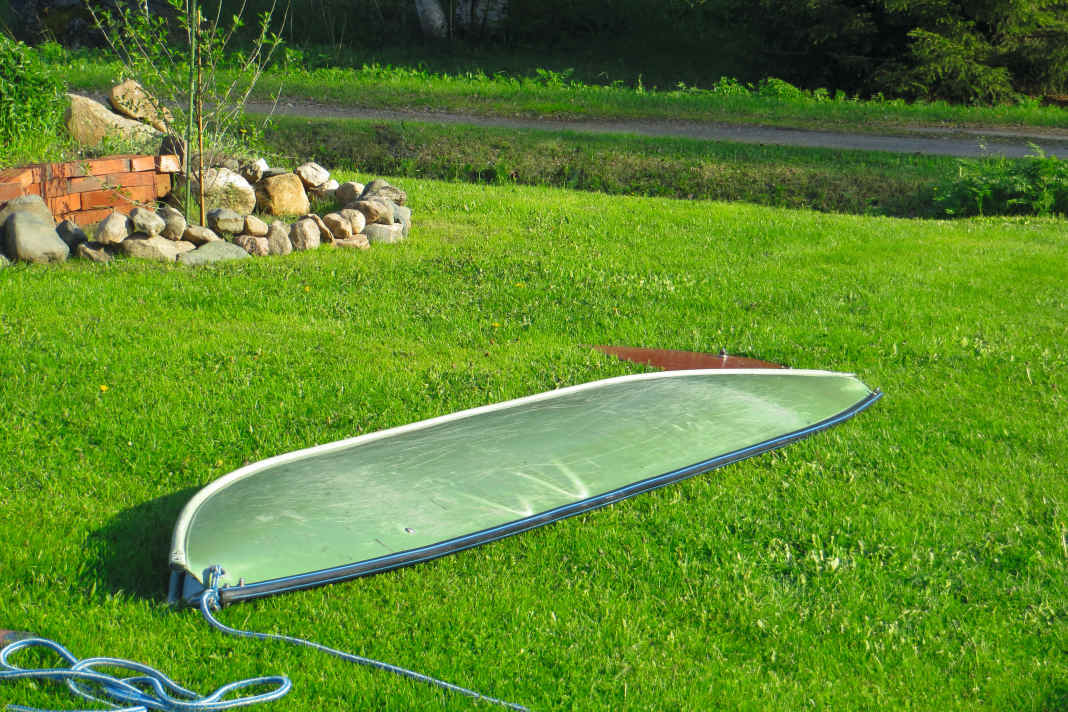





The first thing he gives his dream boat, which he has never given a name, is a steering wheel. "To make it more comfortable to sail," he explains. He finds the material for this in bulky rubbish or at the nearest DIY store. In the case of the steering wheel, it consists of an old pram wheel, sewage pipe covers, aluminium profiles, pulleys and a rope.
Above the steering wheel is a box with a rotating sun visor containing a tablet for navigation. There is also the home-made electronics that convert the twelve volts from a car battery into five volts for the tablet.
He has integrated a mobile Wi-Fi hotspot into the top of the mast. Lenz also optimises his boat with a specially designed boom vang, an improved centreboard holder and a rustic backstay system to stabilise the mast. Aesthetics are never important to him. It has to be functional and cost-effective - and can therefore be repaired anywhere with the simplest of means.
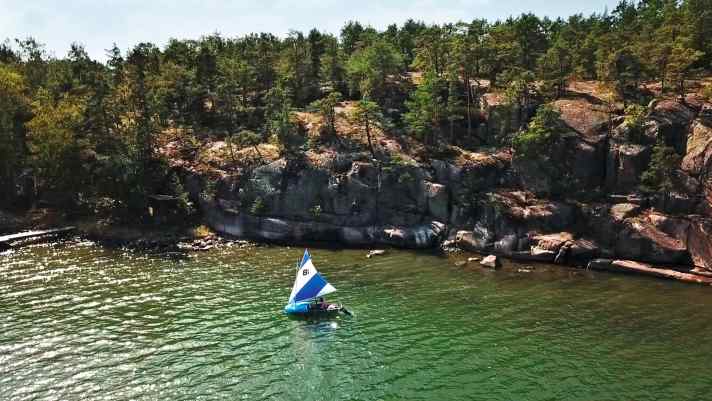
It was 1972, shortly before he began his studies, when Paul Lenz travelled to Finland for the first time. The Scandinavian country captivated him straight away. He even teaches himself Finnish. The language, which is a mystery to most non-Finns, suits the budding civil engineer. Regular hiking holidays take him into the vast nature of the country, and at home in Hanover he accompanies a Finnish folk dance group on the accordion.
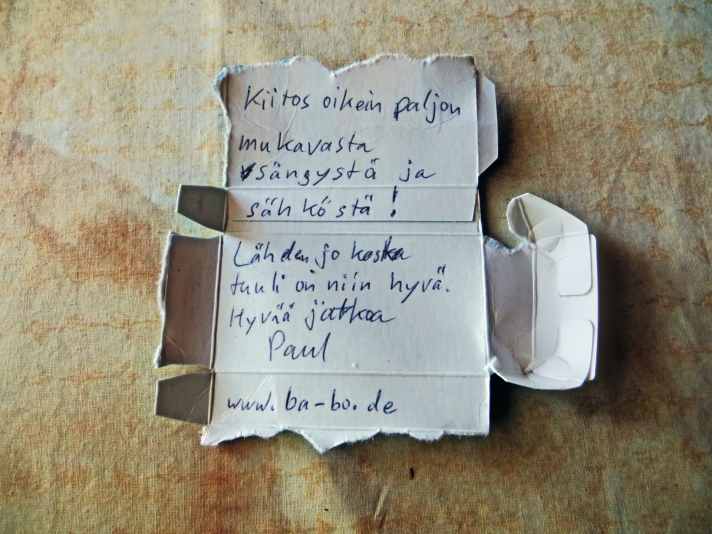
Years later, in 2004, the bridge construction company is closed and Lenz has to look for a new job. He found one on the west coast of Finland, where he worked for four years on the construction of a nuclear power plant. He takes his boat with him and ventures out on longer and longer trips along the coast.
This gave me the idea for my big adventure: to sail the entire route from the Swedish border in the north to the Russian border in the south-east," reports Lenz. "I immediately started planning. However, the result was devastating: I had to plan at least 60 days for the 1,500 kilometre distance. I didn't have that much time back then. So my dream trip had to wait nine years until I retired.
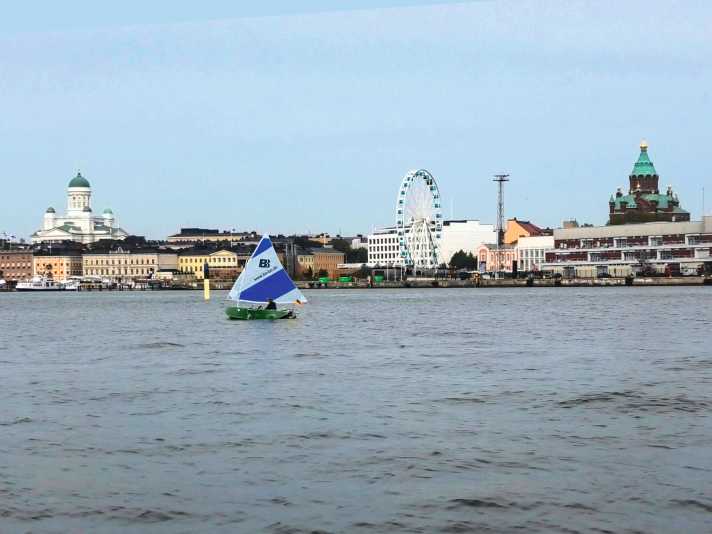
Two weeks after his last day at work, he actually sets off. In Tornio, a town in Lapland right on the border with Sweden, the newly retired man set up his folding boat on 8 June 2019 and launched it into the water. The adventure begins with three hours of rowing against the wind and then cruising along the inner Scandinavian sea border. Exhausted but happy, Lenz sets up camp for the first time on the island of Kuusiluoto.
The igloo tent is only a few metres away from the beach, and as the nights in June are as bright as day, he can see his boat at any time.
This feeling of optimism and a certain lack of planning was overwhelming. Added to this was the certainty that I now had all the time in the world for my project.
The next day, fishermen offer him a hut to spend the night. Early the next morning, the wind is favourable, so he writes a thank-you note on a piece of cardboard and sails on. Due to the early start, he completes the longest leg of his journey that day: an impressive 25 nautical miles. South of the island of Hailuoto, Lenz repeatedly hits sandbanks. The water is too shallow for the centreboards, without them he would drift hopelessly. So he gets out and pulls his boat behind him.
In a small fishing harbour near Siikajoki, Lenz is blown in for a few days.
I had to abort two attempts to sail out of the narrow fairway. The combination of strong headwinds and the sandbanks made it impossible for me to get out of the bay. After four days, the wind finally changed and I was able to set sail again.
Lenz behaves in an extremely exemplary manner when he goes ashore. Rubbish is taken away as a matter of course, and where he has used up firewood in shelters, he chops and saws the exact amount he has taken.
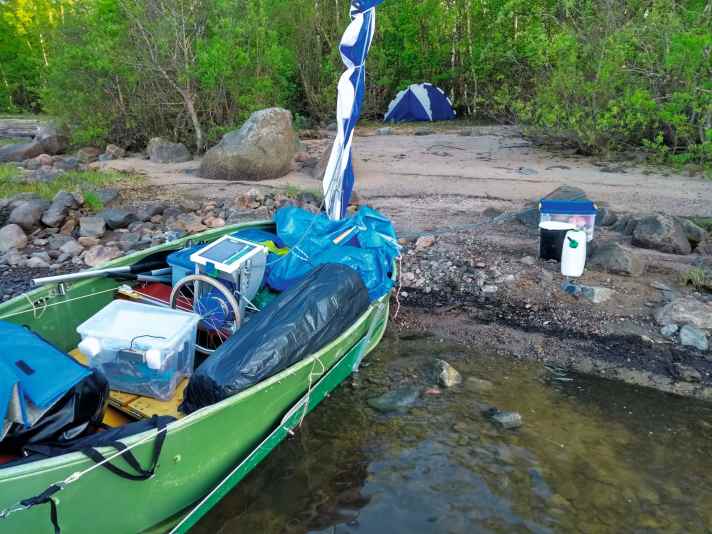
Midsummer is on 22 June and Lenz is celebrating his 66th birthday at the same time. Frugal as he is, he treats himself to Karjalanpiirakka, a Karelian rice pie, and a Tetra-Pak juice from the supermarket. At Kalajoki, the first serious test awaits skipper and boat: extensive shallows lie ahead, with high waves breaking on them. A lot of water swept over the forecastle several times, and Lenz feared the end of his journey. But the lashed spraydeck prevents the worst from happening. Lenz steers faster than the boat can fill up. With willpower, a little luck and plenty of adrenalin in his blood, he reaches his destination for the day.
Perhaps it was the fortunate outcome of this situation that made him too brave weeks later. But he could have been warned. Because even before that, carelessness creeps in here and there. When he wakes up one morning, for example, his boat is gone. "A little tidal range and a gust of wind were enough to tear it loose. Fortunately, I found it only a short distance away, wedged between a few large rocks."
Lenz continues to make his way through the island and coastal landscape of western Finland. In the harbour of Kokkola, he notices that his German flag has gone. So he makes himself a new Adenauer out of a colourful plastic bag. "So much seafaring tradition is a must!" he says.
On the 44th day of his journey, Lenz crosses the cooling water of the nuclear power plant in Olkiluoto, his old workplace. He is now more than halfway through his journey. Days later, after two thirds of the journey, Lenz lands on the small island of Kimonkari. He circumnavigates it on foot in search of a suitable campsite. When he arrives back at the starting point, his boat has drifted away again.
I jumped in after it, but couldn't reach it by swimming. The wind and current were too strong.
Back on the island, he determines the GPS position and contacts the coastguard, who actually recaptures his banana boat and returns it to the grateful owner.
I was really lucky and basically should have had a few penalty laps.
Lenz has now been travelling for 55 days and his willingness to take risks is growing. He is now crossing large expanses of water far from land by the shortest route. After rounding the Tulliniemi peninsula, the southernmost point of the Finnish mainland, he heads eastwards. The days are already getting noticeably shorter. Off Helsinki, the boat survives another nerve-wracking leg with high waves. It goes well again, and the reward is a selfie in front of the skyline of the Finnish capital. For Paul Lenz, "the emotional highlight of the entire journey".
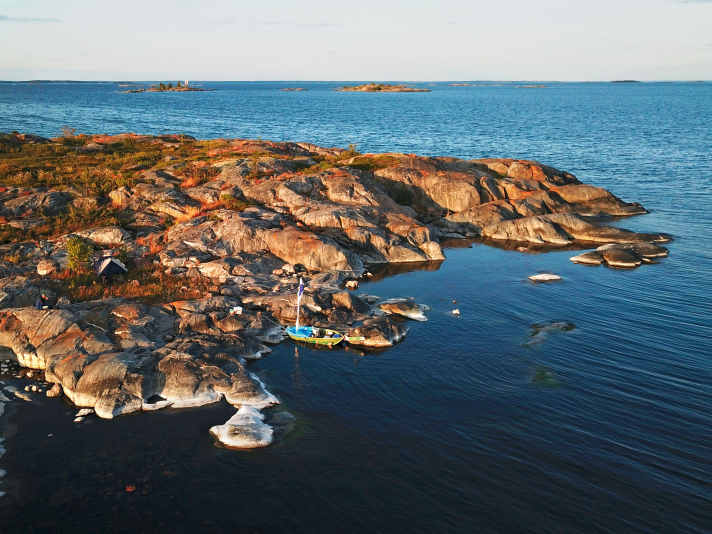
The next day, he sails towards his accident. The wind and waves demand his full concentration, so he doesn't get round to studying the nautical chart properly. He sails blindly into the shallows and suddenly finds himself "surrounded by breakers". The boat capsizes with serious consequences.
By the time I had made it ashore, I was completely dejected. On my socks, I set off in search of a place to stay for the night. With a bit of luck, I found an unlocked summer house with heating, a made-up bed and ingredients for hot soup. Almost too good to be true!
The next day, he writes a letter with his contact details and a promise to pay for everything. Then he borrows another pair of boots and sets off in search of locals.
They are quickly found and immediately inform the coastguard, who pick Lenz up in a patrol boat. After a fruitless search for his boat, Lenz is dropped off on the mainland, where a taxi takes him directly to Helsinki Airport. He always had his identity card and credit card on him so that he could book a flight to Germany. He is back home the same afternoon.
I was deeply saddened by the abrupt end of my journey so close to my destination!
But then, two days later, the big surprise: mail from the Finnish coastguard. His boat has been found and is ready to be picked up.
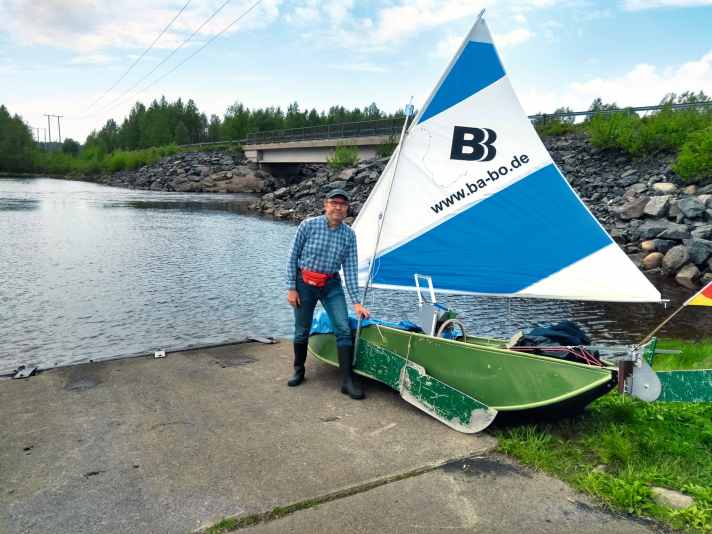
Lenz doesn't hesitate for long, borrows the mast and sail from a banana boat owner friend - these parts had been lost - and heads back to Finland. There he makes a makeshift repair to recreate the highlight of his journey against the backdrop of Helsinki. However, there is no trace of the waterproof bag containing the notebook, drone and memory cards. A large part of his travel documentation seems to be lost forever.
The battered folding boat finally makes its way back to Germany, where Lenz repairs it completely over the course of the winter. What's more, he wants to return and bring his project to a successful conclusion. So in the summer of 2020, he continues where he had to give up the year before.
But first he wants to track down the lost equipment. To this end, he constructs a catamaran equipped with a waterproof video camera. He launches it at the suspected site of the capsize and meticulously searches the bottom. But the endeavour is unsuccessful. The algae bloom has set in and the water is too cloudy. Even multiple snorkelling trips remain unsuccessful.
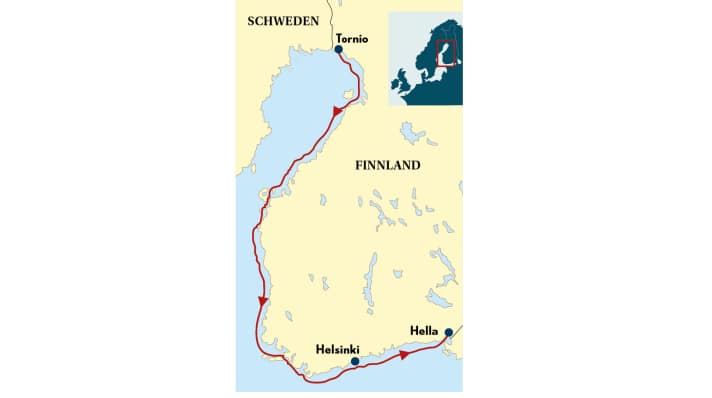
"I finally gave up hope of finding my things and instead looked ahead to the last stretch to the border," says Lenz. The last few kilometres along the border zone with Russia take him through a confusing area. He only finally finds his destination with the help of a new drone he has purchased, which gives him an overview from the air.
After another exciting eleven days, on 3 August 2020, the border at Hella is reached. Paul Lenz has covered 829 nautical miles in 80 days of sailing with his banana boat - a strong performance from a man who describes himself as a landlubber.
But that's not the end of the story: 20 months after the capsize, a bag containing his lost equipment is actually found in Finland. The drone and hard drive are destroyed, but the memory cards with all his photos and videos have survived two Finnish winters - simply incredible!

